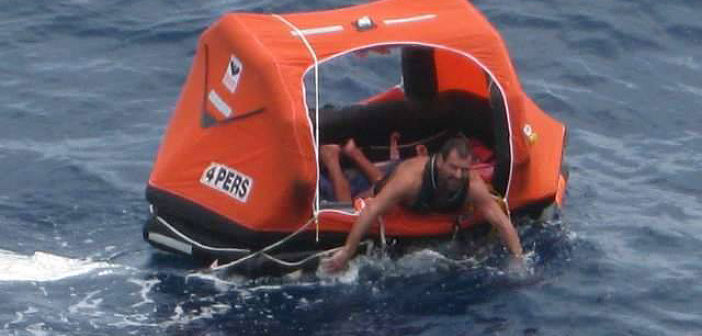Well dear readers, where to begin? A lot has happened since the last blog post on the sailor Matteo Miceli and his solo adventure of sailing around the world in a self-sustaining boat called the Eco40.
So let’s start with Friday the 13th, a very unlucky day for our sailor and for the Eco40 sailboat, which capsized and sank quite suddenly. Luckily, Matteo Miceli did not go down with the ship. He was picked up by the “Aramon”, a merchant vessel flying the flag of the Marshall Islands, after being diverted by the Brazilian maritime authorities with the mission to pick up our solo sailor, who was floating around on a rescue raft some 600 nautical miles off the coast of Brazil. He is now safe, reaching the port of Salvador, Brazil, March 17th.


Matteo afloat 600 miles off the coast of Brazil (left) and his rescue (above).
Matteo is reported to be healthy and although he was very upset about not being able to complete the journey as well as having to leave an important part of his life very abruptly, he was also very glad to be alive.
What happened? On the 12th of March, the Eco40’s rudder was discovered under 300 litres of water. The bushings that had threatened the journey earlier when the Eco40 was near the Prince Edward Islands and the very same ones that Matteo repaired several times ,were stripped, and Matteo lost the keel of the boat (both the blade and bulb).
The function of a keel, for those of us who don’t know much about sailing, is to add stability to the sailboat by using the forward motion of the boat to generate a lift that counteracts the leeward or lower side of the boat’s wind force. In other words, the keel stops the wind from pushing the boat sideways and when the keel is lost, the boat rolls over and capsizes.

The keel increases the stability of the boat.
The security systems and alarms on board the boat went off, warning the Italian Coast Guard in Rome, who organised everything perfectly. The alarm also alerted Matteo and he quickly went out the stern window and got the emergency raft to spring to life. He also rushed back to collect the few supplies and survival stuff he could find. Because it all happened so suddenly, he was only able to save a few things.
Brunette was unfortunately not one of them. By the time Matteo rushed to the external port hole and managed to fish out Brunette, it was too late.
Well, what’s to become of the Eco40’s journey, it’s goals and it’s data?
The Eco40 travelled, from start to its tragic finish, roughly 25,000 nautical miles (approx. 46,000 km) and at the time of its capsizing, was located about 1° north latitude, roughly 600 miles from the Brazilian Coast.
Matteo was lucky. He had rounded all the capes he set out to: The Cape of Good Hope, Cape Leeuwin, Cape Horn; crossed the equator twice and crossed all the meridians he set out to cross. Actually what this means is that Matteo did obtain his goal to travel alone nonstop around the world, from point of departure to point of arrival. He sailed with the Eco40 back and forth across the oceans a few times for 112,4 days at an average speed of 7.4 knots. This sailor had the luck of the devil more than once – even when his boat capsized. Not only because the area in which the boat capsized was known for its calm waters but also because if he had capsized eight hours earlier than he did, he would not have closed the double-crossing of the equator.
Matteo Miceli arrived in Italy on March 19th at Rome’s Fiumicino Airport.
On this journey, he lost more than 30 kilos. After being rescued by the Aramon merchant ship, Matteo was pampered by its crew. He spent his time relaxing, eating and making use of the ship’s gym.
Many thanks to the crew from Matteo.
During the months at sea, the Eco40 collected more than enough data to analyse, document and report results on wave characteristics to produce a polar diagram of the boat’s speed; for improving the Class 40 sailboat structural design and to calculate the height of waves along the boat’s route to validate the numerical models of the UK based Metrology Office.
At the moment, the data collected lies inside the Eco40 floating somewhere in the Atlantic Ocean, 600 nautical miles from the coast of Brazil. An automatic transmitter is still sending a signal, which might enable the Eco40 equipment and data to be recovered.
If there are any further updates, we will keep you informed.
Thank you Matteo for your bravado and good humour during these last months! You’ve kept a wonderful sense of humour these last few months, regardless of what you went through! Below some memorable images of the last few days of the trip.

On the day the boat capsized, Matteo caught a whooper of a fish, ending his famous “chicken grain muesli” diet.
I hope you enjoyed your reads during this 10 part blog posting. I certainly enjoyed covering Matteo’s journey.
Good winds to you all!



















